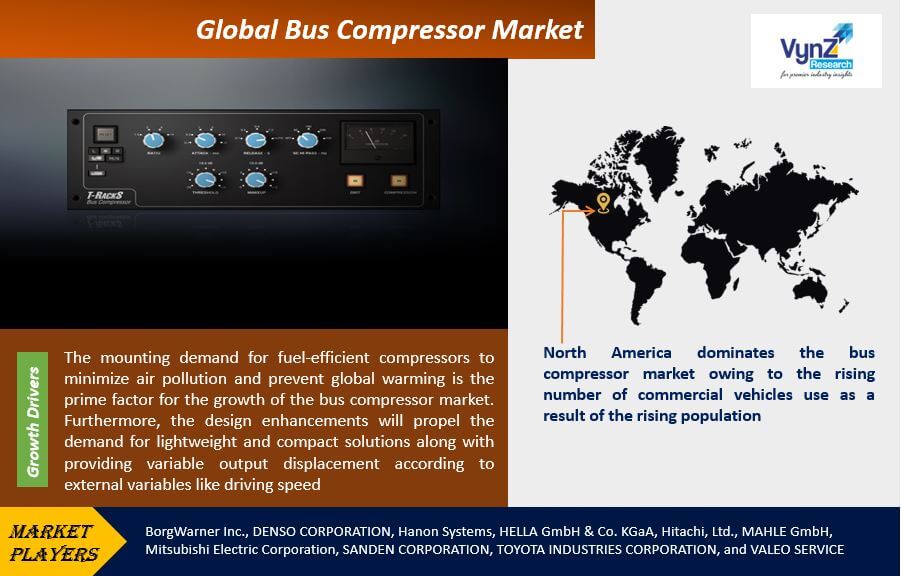| Status : Published | Published On : Dec, 2023 | Report Code : VRAT9615 | Industry : Automotive & Transportation | Available Format :

|
Page : 200 |

Global Bus Compressor Market – Analysis and Forecast (2025-2030)
Industry Insight by Compressor Type (Electric Compressor, Air Compressor (Rotary Screw Compressor, Reciprocating Air Compressor, Axial Compressor, and Centrifugal Compressor), Mechanical Compressor (Swash Plate Compressor, Wobble Plate Compressor, Scroll Compressor), and Others), by Bus Type (Diesel Bus, Gasoline Bus (Petrol/CNG), Electric Bus (Hybrid Electric Buses and Full Electric Bus), and Fuel Cell Bus), by Application (Air Conditioning (AC) and Air Brakes), by Sales Channel (OEMs and Aftermarkets), and Geography (U.S., Canada, Germany, U.K., France, China, Japan, India, and Rest of the World)
Industry Overview
The Global Bus Compressor Market is anticipated to grow from USD 102 billion in 2023 to USD 206.2 billion by 2030, growing at a CAGR of 3.81% between 2025 and 2030. The act of using a compressor on the master output to generate a homogeneous sound for the whole mix or master is known as bus compression.

Bus compression is frequently employed in mixes and masters to give the audio a unified and encompassing tone. Electric air compressors can meet the air supply requirements of high-demand applications such as city buses. As a result, electric air compressors distribute air without relying on the combustion engine and maximize the electric drivetrain's efficiency. Furthermore, air compressors play an important role in powering critical systems on buses and coaches, along with braking and suspension
Owing to relaxation in the COVID-19-related restrictions will result in creating opportunities for growth in the bus compressor market. The demand for hybrid and fuel electric buses will increase, so companies should increase their R&D spending to innovate compressors that meet the demand for city buses in terms of redefining the weight, size, noise, and fuel source of buses.
Bus Compressor Market Segmentation
Insight by Compressor Type
Based on compressor type, the global bus compressor market is categorized into electric compressors, air compressors, mechanical compressors, and others. The air compressor is sub-divided into rotary screw compressor, reciprocating air compressor, Axial compressor, and centrifugal compressor. The mechanical compressor is subdivided into a swash plate compressor, wobble plate compressor, and scroll compressor. The air compressor contributes to the largest share in the bus compressor market as an electric bus uses a rotary screw compressor powered by an internal combustion engine. In comparison to other types of compressors, the rotary screw compressor consumes less power, has fewer parts, has a long lifespan, and is superior fuel-efficient.
Insight by Bus Type
Based on the bus type, the global bus compressor market is segregated into diesel buses, gasoline buses (Petrol/CNG), electric buses, and fuel cell buses. The electric bus is subdivided into hybrid electric buses and fully electric buses. The rising adoption of electric and hybrid buses is growing significantly owing to the state-of-the-art technology which ensures that the bus compressor ensures high efficiency, easy integration, and reliability as they can control and regulate braking systems, assuring fuel consumption reduction, energy efficiency, and reduce pollution emissions.
Insight by Application
Air conditioning (AC) and air brakes are the two applications in the bus compressor market. Among the applications, air conditioning (AC) dominates the bus compressor market. The compressor is a component of the air conditioner that elevates the vapor refrigerant's temperature and pressure. To finish the heat removal process from the condenser, the compressor must boost its temperature. The air compressor is the most critical part of an air conditioner's operation. As a result, the bus compressor market is driven by the increased use of air conditioning in commercial vehicles like buses and coaches.
Insight by Sales Channel
Based on the sales channel, the global bus compressor market is bifurcated into OEMs and aftermarkets. OEMs contribute to the largest share of the bus compressor market. The compressor has a lifespan of 10 to 14 years, which is virtually as long as the bus's life. Only when there is a problem with the AC unit or the air brakes, the compressor is replaced. Otherwise, it will most likely operate throughout the vehicle's life. As a result, compressor replacement is less frequent. This is projected to increase the global bus compressor market.
Global Bus Compressor Market Report Coverage
|
Report Metric |
Details |
|
Historical Period |
2018 - 2023 |
|
Base Year Considered |
2024 |
|
Forecast Period |
2025 - 2030 |
|
Market Size in 2024 |
U.S.D. 102 Billion |
|
Revenue Forecast in 2030 |
U.S.D. 206.2 Billion |
|
Growth Rate |
3.81% |
|
Segments Covered in the Report |
By Compressor Type, By Bus Type, By Application, and By Sales Channel |
|
Report Scope |
Market Trends, Drivers, and Restraints; Revenue Estimation and Forecast; Segmentation Analysis; Impact of COVID-19; Companies’ Strategic Developments; Market Share Analysis of Key Players; Company Profiling |
|
Regions Covered in the Report |
North America,Europe,Asia-Pacific (APAC),Rest of the World (RoW) |
Industry Dynamics
Bus Compressor Industry Trends
The increasing trend to conserve fuel, especially in electric compressors integrated buses to extend the range of vehicles, resulting in the development of smart technologies to understand the need for compressed air and control e-compressor operation, is the trend in the bus compressor market.
Bus Compressor Market Growth Drivers
The mounting demand for fuel-efficient compressors to minimize air pollution and prevent global warming is the prime factor for the growth of the bus compressor market. Furthermore, the design enhancements will propel the demand for lightweight and compact solutions along with providing variable output displacement according to external variables like driving speed, sunlight, and surrounding temperature will accelerate the growth of the bus compressor market. The rising demand for air conditioning as it offers comfort in the vehicle will accelerate the demand for compressors in vehicles as it removes heat and offers cooling inside vehicles, thus bolstering the growth of the bus compressor market. According to the European Environmental Agency, air pollution is Europe's most serious environmental health threat, and automobile emissions have worsened air quality across the continent. The standard belt-driven compressor increases the engine's workload, which affects a vehicle's performance and efficiency, resulting in higher emissions. People and automotive manufacturers have responded to these concerns by adopting fuel-efficient and environmentally friendly alternatives. As a result, the demand for electric compressors is growing in tandem with the desire for fuel-efficient and environmentally friendly solutions. As a result, the global market for bus compressors has grown.
Bus Compressor Market Challenges
The issues related to maintenance costs, huge investment, technical restraints, and the high price of luxury vehicles may hamper the growth of the bus compressor market. The COVID-19 pandemic has disrupted the bus compressor market owing to restrictions regarding lockdowns that have resulted in limited production and transportation delays, hampering the growth of the global bus compressor market.
Bus Compressor Market Opportunities
The evolving and recognized industry players are focusing on hybrid and electric buses to create opportunities for growth in the bus compressor market. Moreover, the rising research and development activities to develop advanced technology will create opportunities for growth in the market.
Bus Compressor Market Geographic Overview
North America dominates the bus compressor market owing to the rising number of commercial vehicles used as a result of the rising population, increasing disposable income, and rising standard of living among people. Furthermore, the rising demand for eco-friendly vehicles and growth in mass production methods like assembly line production will propel the growth of vehicle production in the region.
Bus Compressor Market Competitive Insight
Bus compressor manufacturers provide versatile solutions for compressed air requirements in buses, coaches, trucks, and specialized electric and hybrid vehicles. The firms in the bus compressor industry are tailoring solutions according to the requirements of customers. The industry players are intensifying their business by entering into M&A, collaborations, and partnerships, and establishing new facilities to sustain themselves in the market.
SANDEN CORPORATION focuses on technologies i.e., cooling and heating as key technologies to satisfy the customers. The compressors are the heart of the bus air conditioning system, as they are responsible for refrigerant compression and circulation. Moreover, it has expanded its business in electric vehicles. Their product portfolio includes an electric compressor, fixed displacement type compressor, variable displacement type compressor, and CO2 compressor.
MAHLE has demonstrated a novel air conditioning concept and makes it powerful, and engine-independent. The Compact Variable Compressor (CVC) from MAHLE has a swish plate harmonic motion mechanism that allows it to be controlled pneumatically or electronically. Its product portfolio includes CVC that ranges from 100cc displacement to 185 cc displacement.
BorgWarner Inc., DENSO CORPORATION, Hanon Systems, HELLA GmbH & Co. KGaA, Hitachi, Ltd., MAHLE GmbH, Mitsubishi Electric Corporation, SANDEN CORPORATION, TOYOTA INDUSTRIES CORPORATION, and VALEO SERVICE are the industry players in the bus compressor market.
Recent Developments by Key Players
Mitsubishi Fuso Bus and Truck Corp. (Daimler Truck subsidiary) has launched their next-generation eCanter electric box truck in Hong Kong. It’s the first release of a new-generation Fuso in the Asian market outside of Japan.
Hanon Systems set up a new manufacturing site in Gyeongju, Korea to produce components for eco-friendly vehicles in Korea and shift towards electrified vehicles. The plant is providing a variety of electric vehicle solutions, including heat pump systems and coolant valve assemblies, for Hyundai Motor Group's Ulsan plant's E-GMP (electric global modular platform)-based IONIQ 5, 6, 7, and Genesis vehicles.
Hanon Systems, a renowned producer of automotive, thermal and energy management solutions, opened two new facilities in Hungary. A new greenfield manufacturing facility in Pécs and a building expansion in Rétság. The facility in Pecs has a total area of 22,464 square meters and accommodates equipment that includes forming, brazing, welding, and bending equipment, as well as assembly lines and testing for automotive air conditioning (A/C) lines.
The Bus Compressor Market report offers a comprehensive market segmentation analysis along with an estimation for the forecast period 2025–2030.
Segments Covered in the Report
- By Compressor Type
- Electric Compressor
- Air Compressor
- Rotary Screw Compressor
- Reciprocating Air Compressor
- Axial Compressor
- Centrifugal Compressor
- Mechanical Compressor
- Swash Plate Compressor
- Wobble Plate Compressor
- Scroll Compressor
- Others
- By Bus Type
- Diesel Bus
- Gasoline Bus (Petrol/CNG)
- Electric Bus
- Hybrid Electric Buses
- Full Electric Bus
- Fuel Cell Bus
- By Application
- Air Conditioning (AC)
- Air Brakes
- By Sales Channel
- OEMs
- Aftermarkets
Geographical Segmentation
- North America
- U.S.
- Canada
- Mexico
- Europe
- Germany
- U.K.
- France
- Italy
- Spain
- Russia
- Rest of Europe
- Asia-Pacific (APAC)
- China
- Japan
- India
- South Korea
- Rest of Asia-Pacific
- Rest of the World (RoW)
- Brazil
- Saudi Arabia
- South Africa
- U.A.E.
- Other Countries
.png)
Frequently Asked Questions
Purchase Options
Latest Report
Research Methodology
- Desk Research / Pilot Interviews
- Build Market Size Model
- Research and Analysis
- Final Deliverabvle
Connect With Our Sales Team
- Toll-Free: 1 888 253 3960
- Phone: +91 9960 288 381
- Email: enquiry@vynzresearch.com
Bus Compressor Market
